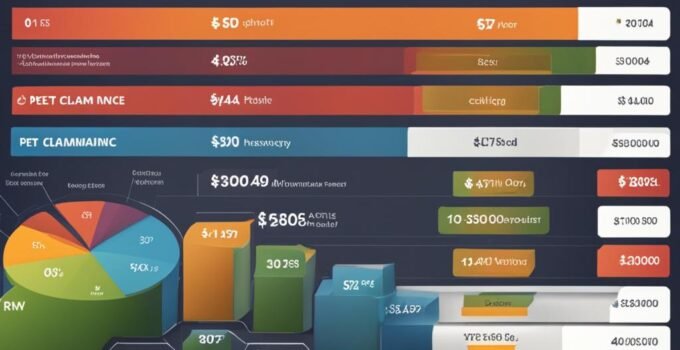When it comes to filing a pet insurance claim, understanding the payment process is essential. Who gets paid – you or your vet? Let’s dive into the details and shed light on pet insurance claim payments and the reimbursement process.
Most pet insurance companies operate on a reimbursement model, where you pay your vet upfront and then submit a claim for reimbursement. This means that you are responsible for paying the vet bill out of pocket, and the insurance company will then reimburse you for the eligible expenses.
It’s important to note that every pet insurance provider may have different payment policies in place. Some companies offer direct payments to the vet, meaning that they will pay the vet directly for the covered expenses. However, these direct vet payment options are not widespread and may vary from one insurer to another.
Before you file a pet insurance claim, it’s crucial to familiarize yourself with your specific pet insurance provider’s payment policies. This will ensure that you understand who is responsible for paying the vet and how the reimbursement process works.
Key Takeaways:
- Pet insurance claim payments typically involve self-payment to the vet and subsequent reimbursement from the insurance company.
- Some pet insurance companies offer direct vet payment options, paying the vet directly for covered expenses.
- Understanding your pet insurance provider’s payment policies is crucial before filing a claim.
- It’s important to know who is responsible for paying the vet and how the reimbursement process works.
- Review your policy to understand the specific payment terms and maximize your pet insurance claims.
How to File a Pet Insurance Claim
Filing a pet insurance claim is a straightforward process that involves a few simple steps. By following these steps, you can ensure a smooth and efficient claim submission process.
- Take your pet to the vet and pay the bill:
- Request an itemized receipt from the vet:
- Fill out the claim form:
- Submit the claim form and required documentation:
- Await reimbursement:
First, take your pet to the vet and pay the veterinary bill at the time of service. It’s important to keep the receipt as it will be required when filing the claim.
Ask your vet for an itemized receipt that details the services provided and their costs. This receipt will serve as evidence of the expenses incurred.
Next, complete the claim form provided by your pet insurance company. This form can usually be accessed online through the insurer’s website or mobile app. Provide accurate and comprehensive information to ensure a smooth processing of your claim.
Once you have filled out the claim form, gather the necessary documentation to substantiate your claim. This may include the itemized receipt from the vet and any relevant medical records. Submit these documents along with the claim form to your pet insurance provider.
After submitting the claim form and required documentation, you will need to await reimbursement from your pet insurance company. The company will review your claim and process the reimbursement accordingly. Reimbursement can be received either through direct deposit or a mailed check.
Pet Insurance Reimbursement
Once you’ve submitted a pet insurance claim, the next step is to understand how the reimbursement process works. This is where you will receive compensation for eligible expenses related to your pet’s medical treatment. The amount you receive in reimbursement will depend on several factors outlined in your policy.
The first factor is the deductible – the amount you have to pay out of pocket before your insurance kicks in. This is typically a fixed amount specified in your policy. The higher your deductible, the lower your monthly premium may be, but the more you’ll have to pay upfront before receiving reimbursement.
The next factor is the reimbursement percentage. This is the percentage of eligible expenses that the insurance company will cover after your deductible has been met. For example, if your policy has a 80% reimbursement percentage and your eligible expenses amount to $1,000, you would be reimbursed $800 after paying the deductible.
Another factor to consider is the annual limit. This is the maximum amount that the insurance company will reimburse you for in a given year. If your expenses exceed this limit, you will be responsible for any costs beyond that amount.
After you’ve submitted your claim, the reimbursement process usually takes several business days. However, the exact timeline can vary depending on the insurance company. Some companies offer direct deposit options, which can provide faster payouts compared to checks sent through the mail.
It’s crucial to review your policy to understand the specific reimbursement terms and percentages. This will ensure that you have a clear understanding of what expenses will be covered and what you can expect to be reimbursed for.
Now let’s take a look at a table that summarizes the pet insurance reimbursement process:
| Factor | Description |
|---|---|
| Deductible | The amount you have to pay out of pocket before insurance coverage kicks in |
| Reimbursement Percentage | The percentage of eligible expenses that the insurance company will cover after the deductible has been met |
| Annual Limit | The maximum amount that the insurance company will reimburse you for in a given year |
| Reimbursement Timeline | The estimated time it takes for the insurance company to process and issue reimbursements |
Understanding the pet insurance reimbursement process is essential for managing your pet’s healthcare expenses. By reviewing your policy, you can clarify the specific terms and understand the factors that determine your reimbursement amount. This knowledge will help you navigate the process and make informed decisions about your pet’s medical care.
Direct Vet Payment Options
While most pet insurance policies require self-payment and subsequent reimbursement, some companies offer direct vet payment options. This means that instead of paying the vet out of pocket and then waiting for reimbursement, the pet insurance company pays the vet directly for covered expenses.
Two examples of pet insurance companies that offer direct vet payment options are Pets Best and Trupanion.
Pets Best requires a reimbursement release form to be signed by the vet. Once the form is submitted, Pets Best will directly reimburse the vet for the covered expenses.
Trupanion offers vet direct pay at checkout if the vet is equipped with Trupanion software. This means that when you take your pet to a Trupanion-affiliated vet, you can pay only your portion of the bill, and Trupanion will pay the vet directly for the covered expenses.
It’s essential to check with your specific pet insurance provider to see if they offer direct vet payment and understand the process involved. This can save you the out-of-pocket expense and the hassle of submitting a reimbursement claim.
Below is an illustrative table comparing the direct vet payment options provided by Pets Best and Trupanion:
| Pet Insurance Company | Direct Vet Payment Option | Process | Requirements |
|---|---|---|---|
| Pets Best | Reimbursement release form | Pets Best reimburses vet directly | Form signed by vet |
| Trupanion | Direct pay at checkout | Trupanion pays vet directly | Vet equipped with Trupanion software |
Required Documentation for Pet Insurance Claims
When filing a pet insurance claim, there are several important documents you will need to provide. These documents ensure that your claim is processed accurately and efficiently, increasing the chances of receiving timely reimbursement. The following are the key documents you should include in your pet insurance claim:
1. Itemized Receipt from the Veterinarian’s Office
An itemized receipt from your veterinarian’s office is essential for your pet insurance claim. This receipt should include a detailed breakdown of all charges and any applicable discounts. It provides proof of the services rendered and the costs associated with your pet’s treatment.
2. Completed Claim Form
Most pet insurance companies require you to fill out a claim form as part of the submission process. This form can usually be conveniently accessed online or through the insurer’s mobile app. Ensure that you provide accurate and complete information on the claim form to avoid any delays or complications in processing your claim.
3. Your Pet’s Medical Records
In addition to the itemized receipt and claim form, including your pet’s medical records is often necessary. This is especially important if it is your first claim or if your insurer requires additional verification. Medical records provide comprehensive details about your pet’s health history and the treatment received, supporting the legitimacy of your claim.
4. Bank Account Information for Direct Deposit Reimbursement
If your pet insurance company offers direct deposit reimbursement, you will need to provide your bank account information. This ensures that the reimbursement amount is efficiently and securely transferred to your designated account. Verify the accuracy of the provided information to avoid any complications in receiving your reimbursement.
By including these necessary documents in your pet insurance claim, you can facilitate the claims process and increase the likelihood of a smooth reimbursement experience. Make sure to double-check the specific requirements of your insurance provider and submit all required documentation promptly.
Calculating Pet Insurance Reimbursement
When it comes to pet insurance reimbursement, the amount you can expect to receive depends on various factors. These factors include your plan’s coverage, deductible, reimbursement percentage, and annual limit. To understand the specific reimbursement calculations for your policy, it’s important to review the terms and conditions provided by your pet insurance company.
Let’s consider an example to illustrate the calculation process. Suppose your vet bill comes to $400, and your pet insurance plan has an 80% reimbursement percentage with a $250 deductible. To calculate your reimbursement, you would take the total bill and subtract the deductible. In this case, the reimbursement amount would be $400 – $250 = $150. Finally, you would multiply the reimbursement amount by the reimbursement percentage to get the final reimbursement. Using our example, the final reimbursement would be $150 * 80% = $120.
It’s important to note that each pet insurance plan is different, so the reimbursement calculations may vary. Reviewing your policy and understanding the specific terms will help you determine how much you can expect to be reimbursed for eligible expenses.
| Factors | Example Values |
|---|---|
| Vet bill | $400 |
| Deductible | $250 |
| Reimbursement percentage | 80% |
| Reimbursement calculation | $400 – $250 = $150 |
| Final reimbursement | $150 * 80% = $120 |
Tracking the Progress of Your Pet Insurance Claim
Once you’ve filed a pet insurance claim, it’s natural to want to stay updated on its progress. Most pet insurance companies provide convenient ways for policyholders to track the status of their claims. By taking advantage of these tracking options, you can ensure that your claim is being processed and stay informed every step of the way.
Online Portal
One common method for tracking your pet insurance claim is through the insurer’s online portal. Simply log in to your account and navigate to the claims section. Here, you can view the current status of your claim, submit any additional documentation if required, and review any important updates or notifications.
Mobile App
If your pet insurance company has a mobile app, you can easily track your claim on the go. Download the app and log in to your account to access the claims feature. From there, you can check the progress of your claim, upload any necessary documents, and receive real-time updates directly to your phone.
Email Updates
Many pet insurance companies also provide updates on your claim status via email. Once you’ve submitted your claim, you can expect to receive periodic emails informing you of any changes or progress. These updates can help you stay informed without needing to constantly check the online portal or app.
Real-Time Progress Tracking
Some pet insurance companies go a step further and offer real-time progress tracking for your claim. This feature allows you to see exactly where your claim is in the process at any time. It provides transparency and peace of mind, knowing that your claim is being actively worked on and not left in limbo.
By familiarizing yourself with the tracking options provided by your pet insurance company, you can easily monitor the progress of your claim and ensure that it is moving forward. Whether through an online portal, mobile app, email updates, or real-time tracking, staying informed will help alleviate any concerns or uncertainties you may have.
Wait Time for Pet Insurance Claim Payout
The wait time for a pet insurance claim payout can vary depending on several factors. The timeframe is influenced by the insurance company, the complexity of the claim, and the chosen reimbursement method. Understanding the expected payout time is essential to properly manage your expectations and plan accordingly.
Some pet insurance providers offer instant reimbursements with direct deposit options, ensuring that you receive your funds quickly. This can significantly reduce the waiting period and provide immediate financial relief.
However, it’s important to note that not all insurers provide instant payouts. In some cases, the processing of pet insurance claims may take several business days. This timeframe can vary depending on factors such as the company’s internal processing procedures and the availability of necessary resources.
More complex cases or claims that require additional documentation may also result in longer wait times. These situations often necessitate further review and verification, which can extend the processing period.
To get a better understanding of the expected payout time for your pet insurance claim, it is advisable to check with your specific insurance provider. They can provide you with accurate information about their processing times and any additional requirements for your claim.
| Factors Affecting Claim Payout Time | Processing Time |
|---|---|
| Insurance Company | Varies; check with your provider |
| Complexity of the Claim | May extend processing time |
| Reimbursement Method | Instant with direct deposit or several business days for other methods |
| Additional Documentation Requirements | May extend processing time |
Handling Pet Insurance Claim Denials or Disagreements
If you find yourself facing a pet insurance claim denial or you disagree with the payout amount, there are steps you can take to address the issue. It’s essential to review your explanation of benefits (EOB) and insurance policy to understand the reason for the denial or the discrepancy in the payout.
An EOB provides a detailed breakdown of the services that were approved and reimbursed or the reasons behind the denial. By carefully reviewing this document, you can identify any discrepancies or gaps in coverage that may have led to the denial or disagreement.
If you believe that the claim denial or payout amount is incorrect, you have the option to appeal the decision with your pet insurance company. In your appeal, provide additional context and any necessary supporting documentation to help strengthen your case. This could include medical records, additional information from your veterinarian, or any other relevant evidence.
If your appeal is unsuccessful, or if you feel that your claim has been unjustly denied, you can also consider filing a complaint with your state’s insurance department. They can assist in resolving disputes between policyholders and insurance providers, ensuring a fair outcome.
Dealing with a pet insurance claim denial or disagreement can be challenging, but by carefully reviewing your documents, appealing the decision, and seeking assistance from the appropriate channels, you can work towards resolving the issue in a fair and satisfactory manner.
Tips for Maximizing Your Pet Insurance Claim
When it comes to pet insurance, maximizing your claims is essential to getting the most out of your coverage. By following these tips, you can ensure a successful pet insurance claim:
- Review your policy: Take the time to thoroughly understand what is covered under your pet insurance policy. This will help you know which expenses are eligible for reimbursement.
- Keep original itemized paid receipts: It’s important to keep all original receipts from your veterinarian visits. These itemized receipts provide the necessary documentation for your claim.
- Complete the claim form accurately: When filling out the claim form, be sure to provide all the necessary information. Any missing or incomplete details may delay or affect the processing of your claim.
- Maintain good communication with your veterinarian: Stay in touch with your veterinarian throughout the treatment process. Ask for detailed notes and records of the services provided. This documentation can be invaluable when submitting your claim.
- Stay informed about the progress of your claim: Follow up regularly with your pet insurance company to track the progress of your claim. Promptly address any issues or additional information requests to ensure a smooth and timely reimbursement process.
By following these tips, you can maximize your pet insurance claim and ensure that you receive the full benefits of your policy.
Conclusion
In conclusion, understanding the process of pet insurance claim payments is essential for pet owners. Depending on the pet insurance company, payments can be made through reimbursement or direct vet payment. When filing a claim, it’s important to provide accurate documentation and follow the insurer’s claim submission process.
The reimbursement amount for pet insurance claims is determined by factors such as the deductible, reimbursement percentage, and annual limit. Tracking the progress of your claim is crucial to ensure timely payment. Familiarizing yourself with the terms and conditions of your pet insurance policy will help you maximize your claims and handle any denials or disagreements.
Whether you opt for reimbursement or direct vet payment, it’s important to have pet insurance coverage to protect your furry companions and provide them with the best possible care. By understanding the pet insurance reimbursement process, you can confidently navigate the claims process and ensure your pets receive the necessary veterinary treatment without financial strain.



